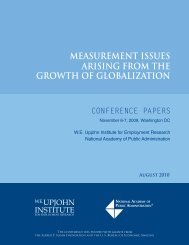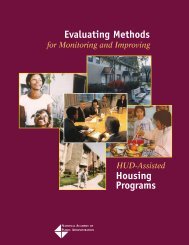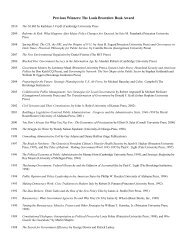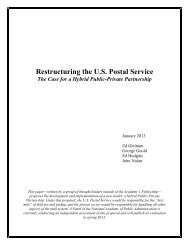High-Performance Partnerships - National Academy of Public ...
High-Performance Partnerships - National Academy of Public ...
High-Performance Partnerships - National Academy of Public ...
You also want an ePaper? Increase the reach of your titles
YUMPU automatically turns print PDFs into web optimized ePapers that Google loves.
eform to establish some form <strong>of</strong> results-based<br />
budgeting and to require agencies to report<br />
associated performance outcomes.<br />
The American State Administrators Project<br />
surveyed 1,200 state administrators on their<br />
actions to implement proposals related to<br />
Gaebler and Osborne’s principles. Although<br />
the principles primarily concern management<br />
reforms, three specifically relate to performance-based<br />
partnerships between public agencies<br />
and nonpr<strong>of</strong>it organizations: missiondriven<br />
strategic planning projects, privatization<br />
<strong>of</strong> major programs, and benchmarks for<br />
measuring program outcomes and results.<br />
Nearly 80 percent <strong>of</strong> the survey respondents<br />
indicated that they had fully or partially implemented<br />
mission-driven strategic planning<br />
projects, and a quarter said they had done so<br />
for major program privatization. Meanwhile,<br />
62 percent reported that they were at various<br />
stages in benchmarking for measuring outcomes<br />
(Brudney et al. 1999). These strategies<br />
can provide the force for outcome-focused<br />
cross-sector partnerships that increase the likelihood<br />
<strong>of</strong> achieving results.<br />
At the local level, management reform trends<br />
are similar, though not as widespread.<br />
Detailed survey data indicate that 38 percent <strong>of</strong><br />
responding cities <strong>of</strong> more than 25,000 residents<br />
used performance measures. 5 This practice<br />
is more prevalent in larger cities; half <strong>of</strong><br />
those cities with populations <strong>of</strong> 100,000 to<br />
249,999 reported using performance measures,<br />
as did three-quarters <strong>of</strong> cities <strong>of</strong> 250,000 or<br />
more. Further, the approach is used more frequently<br />
in cities with a council-manager form<br />
<strong>of</strong> government than those with a mayor-council<br />
system (Poister and Streib 1999). County<br />
level governments have embraced new public<br />
management reforms, as well. A 1998 survey<br />
<strong>of</strong> counties with populations <strong>of</strong> 50,000 or<br />
more indicated that approximately 34 percent<br />
used some type <strong>of</strong> performance measurement<br />
(Berman and Xiao-Hu Wang 2000).<br />
For the most part, public/nonpr<strong>of</strong>it relationships<br />
have been based on grant agreements<br />
and vendor contracts. From child and foster<br />
care to health care and job training, providers<br />
were held accountable for units <strong>of</strong> service<br />
Historically, the City <strong>of</strong> Richmond underwrote<br />
the costs <strong>of</strong> community development corporations<br />
because they worked in distressed neighborhoods.<br />
In Neighborhoods in Bloom, the<br />
emphasis shifted to funding specific outcomes.<br />
Success is determined by the number <strong>of</strong> housing<br />
units produced and overall neighborhood<br />
improvement as measured by increased housing<br />
values and crime and blight reduction.<br />
TK Somanath and David Sacks,<br />
Neighborhoods in Bloom (Richmond)<br />
delivered, not for long-term outcomes or<br />
results in local neighborhoods and families.<br />
More recently, however, demands for accountability<br />
have increased. Agencies and organizations<br />
report outcome goals that focus on the<br />
qualitative impact <strong>of</strong> the service. Examples<br />
include: Did job placement trainees develop<br />
marketable skills as evidenced by sustained<br />
employment? Did rates <strong>of</strong> preventable diseases<br />
decrease among families that participated in<br />
health education programs?<br />
COLLABORATION:<br />
THE THING TO DO<br />
Emphasizing performance and maximizing<br />
limited resources have led the public and nonpr<strong>of</strong>it<br />
sectors to explore new ways <strong>of</strong> working<br />
together. Legislation and public policies also<br />
have encouraged partnerships. In short, collaboration<br />
has become “the thing to do.”<br />
The U.S. Department <strong>of</strong> Housing and Urban<br />
Development’s Continuum <strong>of</strong> Care program<br />
requires that homeless service providers plan<br />
and submit federal funding applications<br />
together. The urban and rural empowerment<br />
zone/enterprise projects are explicitly designed<br />
to leverage government funds and business<br />
sector investments for community economic<br />
5. The response rate to this survey was 57 percent, or 695 out <strong>of</strong> 1,218 senior <strong>of</strong>ficials.<br />
27 Powering the Future: <strong>High</strong>-<strong>Performance</strong> <strong>Partnerships</strong>









